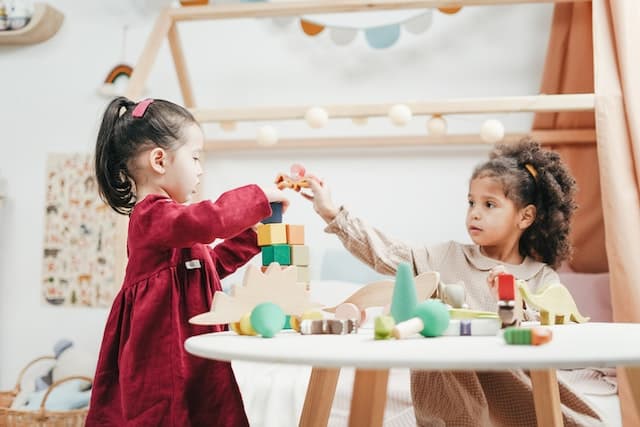The Importance of Play-Based Learning for Young Children
Play-based learning refers to an educational approach that emphasizes the use of play as a primary method for children’s learning and development. It involves engaging children in purposeful and meaningful play activities that are designed to promote their cognitive, social, emotional, and physical growth. Play-based learning recognizes that children learn best through active exploration, experimentation, and interaction with their environment and peers.
Benefits of play-based learning
Play-based learning has gained significant attention and recognition for its multitude of benefits in early childhood education. It goes beyond mere entertainment and holds immense value in fostering holistic development among young children. This approach recognizes that play is a powerful tool for learning, enabling children to explore, experiment, and engage with the world around them in meaningful ways. By incorporating play into educational settings, children are empowered to develop essential cognitive, social, emotional, and physical skills that form the foundation for lifelong learning. This article explores its various benefits, shedding light on how it supports children’s overall growth and prepares them for future success. From enhancing problem-solving abilities to promoting social interaction and creativity, this kind of learning offers a rich array of advantages that contribute to a well-rounded education for young children.
A. Cognitive development
- Enhancing problem-solving and critical thinking skills: This learning provides children with opportunities to encounter challenges, solve problems, and make decisions independently. Through play, they develop critical thinking skills, learn to think flexibly and become adept at finding innovative solutions to various problems.
- Stimulating creativity and imagination: Play-based activities encourage children to use their imagination, think creatively, and explore new ideas. Whether it’s building with blocks, engaging in pretend play, or engaging in open-ended art activities, play nurtures creative thinking and fosters originality.
B. Social and emotional development
- Building communication and collaboration skills: This learning involves interaction with peers, promoting the development of communication and collaboration skills. Children learn to express their ideas, listen to others, negotiate, and cooperate, thus enhancing their social competence and building positive relationships.
- Developing empathy and self-regulation: Play offers children opportunities to understand and relate to other’s feelings and perspectives, promoting empathy and emotional intelligence. Additionally, play helps children regulate their emotions as they navigate various social situations, learn to take turns, share, and manage conflicts constructively.
C. Physical development
- Improving fine and gross motor skills: It often involves activities that require fine and gross motor skills, such as building, drawing, running, and climbing. These activities strengthen muscle control, hand-eye coordination, and spatial awareness, contributing to overall physical development.
- Promoting healthy lifestyles and physical activity: It encourages active engagement, promoting physical activity and healthy lifestyles. Whether it’s engaging in outdoor games, dance, or sports, play supports children’s physical fitness, helps develop stamina, and instills habits of regular exercise.
Incorporating this learning into early childhood education creates an enriching and holistic learning environment. It nurtures children’s cognitive, social, emotional, and physical development, equipping them with essential skills for lifelong learning and success. By recognizing the significance of play in education, we can unlock the full potential of young children and foster a love for learning that extends far beyond the early years.
Play-based learning in practice
Play-based learning in practice involves creating a supportive environment where children can engage in open-ended play and exploration. Teachers and parents play a crucial role in observing and facilitating learning opportunities, balancing structured instruction with free play time. This approach fosters children’s natural curiosity, creativity, and joy of learning.
A. Creating a supportive environment
- Providing open-ended materials and diverse play options: A play-based learning environment should offer a wide range of open-ended materials, such as blocks, art supplies, and manipulatives, allowing children to use their imagination and explore various possibilities. Diverse play options encourage creativity, problem-solving, and self-expression.
- Allowing for child-led exploration and decision-making: Giving children the autonomy to choose their activities and direct their play fosters independence and decision-making skills. It enables them to follow their interests, engage in meaningful exploration, and take ownership of their learning experiences.
B. Role of teachers and parents
- Observing and facilitating learning opportunities: Teachers and parents actively observe children during play to understand their strengths, interests, and areas for growth. They seize teachable moments, ask open-ended questions, and provide guidance or resources that support children’s learning and extend their thinking.
- Balancing structured instruction with free play time: While structured instruction has its place, it is crucial to strike a balance by allowing ample time for free play. This balance ensures that children have opportunities for self-directed learning, social interaction, and creative exploration, which are integral to play-based learning.
Creating a supportive environment and involving teachers and parents in the process are key elements of effective play-based learning. By providing open-ended materials, promoting child-led exploration, and maintaining a balanced approach, children can fully engage in play-based activities and experience the numerous benefits it offers for their development and learning.
Addressing misconceptions and challenges
By addressing counterarguments and implementing strategies to overcome challenges, the value of play-based learning can be effectively conveyed to stakeholders. Emphasizing its positive impact on academic readiness and demonstrating how play can be integrated into the curriculum, educators can create an environment that embraces play-based approaches, ultimately benefiting the holistic development and learning outcomes of young children.
A. Counterarguments against play-based learning
- Concerns over academic readiness: Some argue that play-based learning may not adequately prepare children for academic success. However, research has shown that play-based approaches promote a solid foundation for future learning by fostering critical thinking, problem-solving, and creativity, which are essential for academic achievement.
- Balancing play with curriculum requirements: Critics contend that play-based learning may conflict with meeting curriculum standards. However, play-based approaches can be seamlessly integrated into curriculum planning, ensuring that learning objectives are met while allowing children to engage in purposeful and meaningful play experiences.
B. Strategies for overcoming challenges
- Communicating the benefits to stakeholders: Educators, parents, and policymakers need to understand the research-backed benefits of this learning. By effectively communicating how play supports children’s cognitive, social, emotional, and physical development, misconceptions can be addressed, and support for play-based approaches can be fostered.
- Integrating play-based learning into curriculum planning: This learning can be integrated into curriculum planning by identifying learning goals and aligning play activities with specific educational objectives. By intentionally designing play experiences that target desired outcomes, educators can demonstrate how play and curriculum requirements can coexist harmoniously.
Conclusion
In conclusion, play-based learning holds significant importance and offers numerous benefits in early childhood education. It serves as a powerful tool for children’s cognitive, social, emotional, and physical development. By engaging in play-based activities, children enhance their problem-solving and critical thinking skills, stimulate creativity and imagination, build communication and collaboration skills, develop empathy and self-regulation, improve fine and gross motor skills, and promote healthy lifestyles and physical activity. It provides a holistic approach that nurtures children’s overall growth and prepares them for future success.
To maximize the potential of play-based learning, it is crucial to encourage adoption and support for such approaches in early childhood education. Educators, parents, and policymakers should recognize the value of play as a fundamental aspect of learning and advocate for its integration into educational settings. By promoting its benefits, communicating its positive outcomes, and providing professional development opportunities for educators, we can create a wider understanding and appreciation for this approach. Additionally, incorporating play-based learning into curriculum planning and instructional practices ensures its seamless integration into educational frameworks.
By embracing play-based learning, we can create an educational environment that fosters children’s natural curiosity, joy of learning, and holistic development. Let us champion play as a powerful medium for young children’s growth and actively support its implementation in early childhood education to unlock the full potential of every child.

